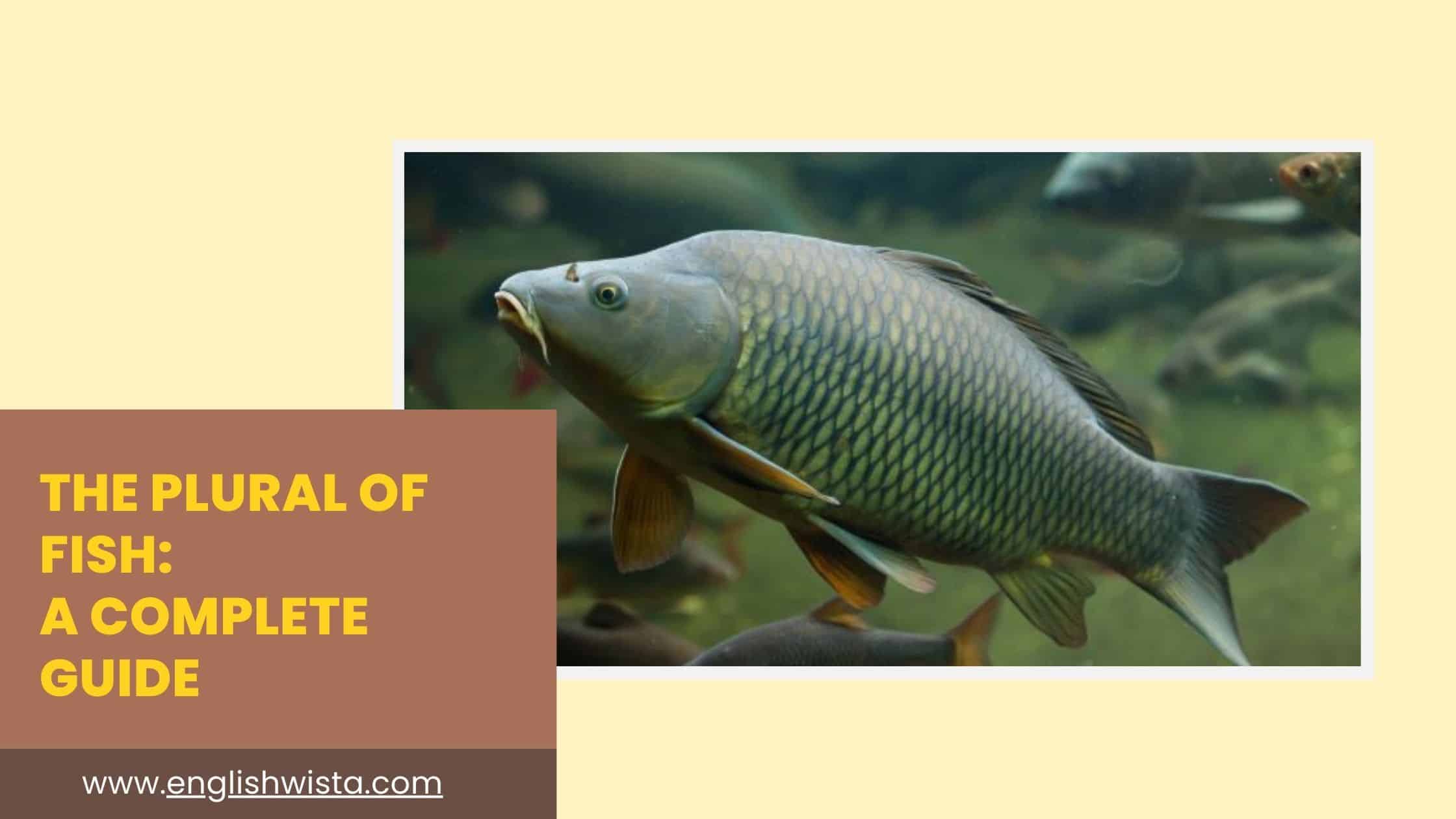Have you ever found yourself staring at a sentence, wondering whether to write “fish” or “fishes”? You’re definitely not alone! The plural form of “fish” is one of those tricky English language puzzles that can make even confident speakers pause and scratch their heads.
Here’s the good news: once you understand the simple rules, you’ll never have to guess again. Whether you’re writing about your weekend fishing trip, describing an aquarium, or just trying to sound more natural in English, this guide will help you master the plural of fish once and for all.
Let’s dive in and explore this fascinating topic together. You’ll discover that the answer isn’t as straightforward as you might think, but it’s much easier to understand than you might fear.
What is the Plural of Fish?
The simple answer is: both “fish” and “fishes” can be correct! But here’s where it gets interesting – they’re used in different situations.
Fish (same as singular) is the most common plural form. You use this when talking about multiple fish of the same type or when referring to fish in general.
Fishes is used when you’re talking about multiple different species or types of fish.
Think of it this way: if you catch five salmon, you caught five fish. But if you catch a salmon, a trout, and a bass, you caught three different fishes.
This might sound confusing at first, but don’t worry. We’ll break it down with plenty of examples to make it crystal clear.
When Do You Use “Fish” as the Plural?
Most of the time, you’ll use “fish” as the plural form. This is the version you’ll hear in everyday conversation and see in most writing.
Here are the main situations where “fish” works perfectly:
Talking about the same species:
- I saw ten fish swimming in the pond.
- The fisherman caught twelve fish today.
- Those colorful fish are all goldfish.
General references to fish:
- Fish are amazing creatures.
- Do you like eating fish?
- The aquarium has hundreds of fish.
In scientific contexts (sometimes):
- The study examined how fish respond to temperature changes.
- These fish migrate every spring.
Remember, when you’re unsure, “fish” is almost always the safe choice. Native speakers use this form about 90% of the time.
When Do You Use “Fishes” as the Plural?
Now let’s talk about “fishes.” This form is less common, but it has specific uses that make it very important in certain contexts.
You use “fishes” when you want to emphasize that you’re talking about different species or types of fish.
Scientific and academic writing:
- The researcher studied five different fishes from the coral reef.
- These tropical fishes have unique feeding habits.
- The lake contains several endangered fishes.
When emphasizing variety:
- The aquarium displays fishes from around the world.
- Different fishes require different care.
- The menu features fishes from both freshwater and saltwater.
Biblical or formal language:
- Jesus fed the multitude with loaves and fishes.
- The parable speaks of nets filled with many fishes.
Think of “fishes” as the more formal, scientific, or specific version. It’s like the difference between saying “dogs” (general) and “canines” (more specific or scientific).
Common Mistakes People Make
Let’s address some confusion that often comes up with fish plurals.
Mistake 1: Always using “fishes” Some people think “fishes” sounds more correct or educated. But using it all the time actually sounds unnatural to native speakers.
Wrong: “I fed the fishes in my tank.” Right: “I fed the fish in my tank.”
Mistake 2: Never using “fishes” On the flip side, some people avoid “fishes” entirely. But sometimes it’s the better choice.
Awkward: “The biologist studied three types of fish.” Better: “The biologist studied three types of fishes.”
Mistake 3: Mixing them inconsistently Pick one form and stick with it in the same context. Don’t switch back and forth without reason.
Real-Life Examples in Context
Let’s look at some practical examples to see how this works in real situations.
At the grocery store:
- “Do you sell fresh fish?” (general question)
- “What kinds of fishes do you have?” (asking about varieties)
At an aquarium:
- “Look at all those beautiful fish!” (general excitement)
- “This exhibit shows fishes from the Amazon River.” (scientific display)
Talking about pets:
- “My fish seem happy in their new tank.” (your pet fish)
- “Different fishes need different water temperatures.” (various species)
In cooking:
- “I’m making fish for dinner.” (the food)
- “This cookbook has recipes for many different fishes.” (various species)
Notice how the context helps determine which form feels more natural.
Why Does English Have This Weird Rule?
You might wonder why English makes this seemingly simple word so complicated. There’s actually an interesting reason!
The word “fish” is what linguists call an “invariant plural.” This means the singular and plural forms look the same. English has several words like this: sheep, deer, moose, and aircraft.
The form “fishes” developed later as a way to specifically talk about different species. It’s similar to how we might say “peoples” when talking about different ethnic groups, even though “people” is usually the plural of “person.”
This double system gives English speakers more precise ways to express meaning. Pretty clever, right?
Other Animals with Similar Rules
Fish isn’t the only animal that works this way. Understanding these patterns can help you remember the fish rule better.
Animals that stay the same:
- One deer, many deer
- One sheep, many sheep
- One moose, many moose
Special plural rules for animals:
- One mouse, many mice
- One goose, many geese
- One child, many children
Animals that can go both ways (like fish):
- One shrimp, many shrimp OR many shrimps
- One squid, many squid OR many squids
Seeing these patterns helps you understand that English plural rules aren’t random – they follow certain historical and logical patterns.
Tips for Remembering the Rule
Here are some simple tricks to help you remember when to use “fish” vs “fishes”:
The Species Test: Ask yourself: “Am I talking about different types?” If yes, consider “fishes.” If no, use “fish.”
The Formality Check: Is this scientific or academic writing? “Fishes” might be appropriate. Is this casual conversation? Stick with “fish.”
The Safety Rule: When in doubt, use “fish.” It’s correct 90% of the time and never sounds wrong to native speakers.
The Context Clue: Look at what you’re writing about. Pet store signs usually say “tropical fish.” Scientific papers often say “reef fishes.”
Regional and Cultural Differences
Interestingly, different English-speaking communities sometimes prefer one form over the other.
In American English, “fish” is overwhelmingly preferred in most contexts. Americans rarely say “fishes” except in very formal or scientific settings.
British English speakers are slightly more likely to use “fishes,” especially in formal writing, but “fish” is still more common.
In scientific communities worldwide, “fishes” appears more frequently because researchers often discuss multiple species.
The Bible and religious texts traditionally use “fishes,” which influences some formal or traditional writing styles.
Don’t worry too much about these differences. Both forms are understood everywhere English is spoken.
What About Baby Fish?
While we’re talking about fish words, you might wonder: what do you call baby fish?
The general term is “fry” (both singular and plural). You might also hear “fingerlings” for slightly older young fish.
- The fish laid eggs that hatched into fry.
- These fingerlings will grow quickly.
- Look at all the tiny fry swimming around!
Just like adult fish, you don’t usually say “fries” when talking about baby fish (that would be confusing with French fries anyway!).
Fish in Expressions and Idioms
English has many expressions that use the word “fish.” Here’s how the plural works in common sayings:
Common expressions:
- “There are plenty of fish in the sea” (not fishes)
- “Like shooting fish in a barrel” (not fishes)
- “A big fish in a small pond” (usually singular)
When “fishes” appears:
- “All fishes great and small” (formal/poetic)
- “Different fishes for different dishes” (emphasizing variety)
These expressions follow the same rules we’ve discussed, but they’re often fixed phrases that don’t change much.
Conclusion
Now you know the secret to using “fish” and “fishes” correctly! Let’s recap the key points:
Use “fish” (same as singular) most of the time. This works for multiple fish of the same type, general references, and everyday conversation. It’s your safe, go-to choice.
Use “fishes” when you specifically want to talk about different species or types of fish. This is more common in scientific writing, formal contexts, or when emphasizing variety.
Remember, both forms are correct in their proper contexts. Don’t stress too much about choosing perfectly every time – native speakers will understand you either way.
The most important thing is to be consistent within your writing and to remember that “fish” is almost always the right choice for casual conversation. With practice, you’ll develop a natural feel for when each form sounds right.
Now you’re ready to talk about fish with confidence, whether you’re at the pet store, reading a science article, or just chatting with friends about your latest aquarium additions. Happy talking about fish!



